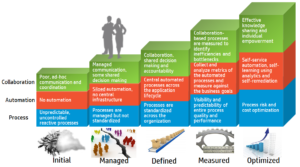Whenever we buy something, we have to compare options, and for each one we ask “Can they give me what I want?” If you want reliable personal transportation you might look for a manufacturer with years of published reliability statistics covering hundreds of thousands of vehicles. If you’re looking for the most exciting ride possible you might search out an innovator like Simone Giertz.
Maturity models give us a way to compare the ability of different organizations. They’re a checklist. Wikipedias article “Capability Maturity Model” describes how to assess the ability of a contractor to implement a software project. After all, why would you want a chaotic vendor when you could get an optimized one?
Of course, the capability assessment process is hilarious for anyone with real experience writing software! We’ve all switched to Agile because we get software that better delivers value faster. Consider the startup that actually delivered Healthcare.gov as a perfect example of the success of Agile and the failure of using a capability maturity model to guide a development process.
Marketing departments have discovered maturity models, too, and turned them around. Instead of a tool to evaluate vendors, they’re a tool for vendors to ‘help’ customers evaluate themselves. It’s perfect click-bait. “Are You Immature?” And when you discover you are? You guessed it, “Five Steps to Perfect Maturity” using their wonderful products!
Hewlett Packard Enterprise is sure you're immature.
Actually, we all need to be operating in all of the maturity stages at once. Look around your IT department and I’m sure you’ll find that there are some parts of your IT that match the immature stages, others that are optimized, and a whole bunch that are in-between. All at the same time.
That’s because we’re constantly reinventing ourselves. We turn wild ideas (3d printers!) into stable products (NetApp Flexpod), and eventually buy directly from a supplier (120VAC). And then we build new wild ideas on top of those commodity supplier products!
Maturity Models Value
The value in a maturity model is that it can help you recognize whether you’re appropriately dealing with the technology you’re using. Tons of required automation, metrics, and predictability is no way to come up with new ideas. Once you’ve found a new idea has value, it’s time to turn it into a product and that means collaboration, accountability, and measurement. And then when you see that the product you’ve built is available from an outside supplier, you need to stop building and maintaining your product and convert to the commodity.
By the way, that’s a tri-modal management model, not a bi-modal model. You can think of them as inventors, productizers, and suppliers – but I like Swardley’s terms – Pioneers, Settlers, and Town Planners instead.
So go ahead and use those maturity models – not to create an end goal, but as a guide to your local territory. And have fun building some wild ideas, or converting crazy notions into profitable products, or saving vast amounts of money by outsourcing! The real maturity model embraces all three.
Interested in learning more? Enter your email address below to subscribe to our blog!










